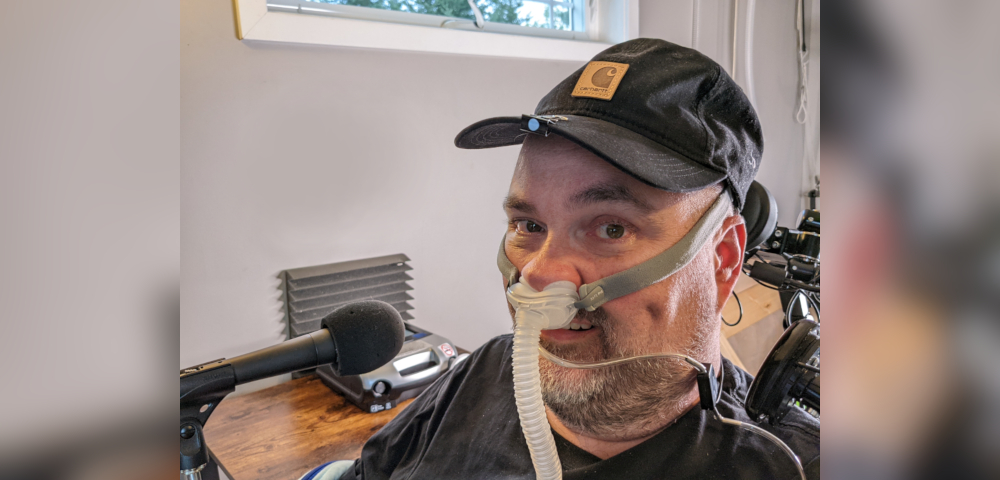Improving my husband’s comfort feels like a win
Placing a nasal pillows mask correctly can be harder than it seems

Ever since my husband Todd’s ALS led to his paralysis, it has been hard for him to get comfortable. This is especially true now that he wears a mask nearly 24/7 for noninvasive ventilation support.
For years, I’ve jumped into action when he calls me to swat a mosquito, adjust a finger, or scratch an itch. I feel for him. I’ve tried putting myself in his shoes by leaving my own itch go unscratched, and I can’t hold out for long. I can hardly imagine what it’s like when I leave the house and a mosquito lands on him.
But all of that pales in comparison to the discomfort he feels when his nasal pillows aren’t on straight and he has uneven pressure around his nostrils. “It’s about as comfortable as it looks,” Todd often says wryly.

Todd wears an AirFit P10 nasal pillows mask. (Photo by Kristin Neva)
Finding a comfortable mask
He initially tried different ventilation masks. A full face mask removes his ability to speak, one of the few capabilities Todd has maintained after 13 years with the disease. A full face mask would also prevent him from using his sip-and-puff device to click his mouse, so it isn’t a good option. Another option, the nasal mask, would cover only his nose, but he didn’t find it comfortable. We might try that one if we get really desperate, but so far we’ve had the most success with the nasal pillows masks.
The nasal pillows are used with several of ResMed’s AirFit masks. The P10 has elastic bands that wrap around his head, and the tube from the ventilator stretches to his nose. The P30i has tubes that run along his cheeks to the top of his head, where the mask connects to the tube from the ventilator. He only uses the latter type of mask when he is in bed, lying on his back. He uses the P10 when he is lying on his side or he is set up at his computer.
We need to replace and wash the elastic bands about once a week to keep his head from getting itchy, but that’s not the biggest issue. The problem is actually placing the nasal pillows on his nose, and then realizing when they have broken down and need to be replaced.
If they aren’t placed correctly or if they are old, they leak around the edges and dry out his nostrils. Worse, the silicone edges around the openings cut into his skin. I’ve had to treat bloody sores around his nose, and he’s had to continue wearing the mask while his skin healed.
I’ve spent a lot of time microadjusting — pushing the pillows one way and then the other, pushing them further into each nostril with a cotton swab, and adjusting the bands around his head or over his ears. It’s a frustrating process for both of us. I do my best and sometimes get it, but other times he just gives up and says it’s close enough. He deals with the imperfection.
“Only one of my caregivers is really good at it,” Todd told me. Apparently, I was in the bottom tier.
“I don’t know how she does it,” he said. “I think she pries the pillows apart.”
I tried that, but it seemed even worse.
Last night, when that particular caregiver came in for her shift, I asked her to show me what she does. She bends the base of the mask back as she places the pillows into the nostrils. That made more sense than what I was doing, which was pushing the pillows apart from the center.
I tried her method and it worked.
“Perfect,” Todd said. “That is so much more comfortable.”
Today I’ve spent much less time fiddling with his mask, and now I’ll show his other caregivers this new method.
Little things make such a difference with ALS, so this feels like a win.
Note: ALS News Today is strictly a news and information website about the disease. It does not provide medical advice, diagnosis, or treatment. This content is not intended to be a substitute for professional medical advice, diagnosis, or treatment. Always seek the advice of your physician or other qualified health provider with any questions you may have regarding a medical condition. Never disregard professional medical advice or delay in seeking it because of something you have read on this website. The opinions expressed in this column are not those of ALS News Today or its parent company, BioNews, and are intended to spark discussion about issues pertaining to ALS.








Comments
Christine Gilmore
https://cpapx.com/products/resmed-airfit-p30i-nasal-pillow-mask-starter-pack?utm_campaign=gs-2022-06-29&utm_source=google&utm_medium=smart_campaign&gad=1&gclid=EAIaIQobChMI5J3FlMXf_wIVyQetBh0OzwtYEAQYCSABEgItm_D_BwE Here’s what I use. I’m not sure if I could deal with the tubing hanging below my nose.
Kristin Neva
Thanks for sharing! He uses that one at night but finds it too heavy for his neck when he is sitting up. We have talked about trying to find a way to hang it from an attachment to his wheelchair so he could use it during the day too.